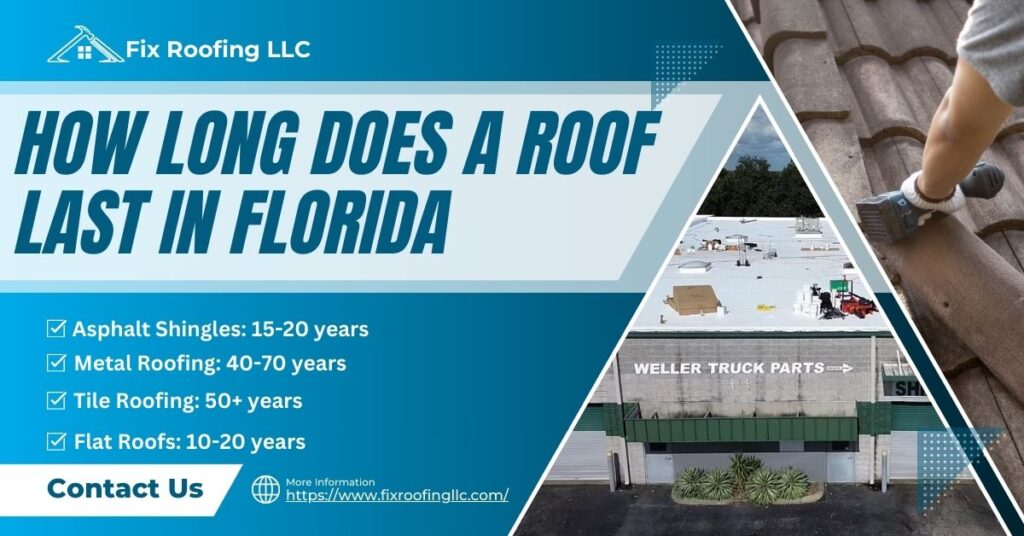What Every Homeowner Needs to Know About Lifespan, Maintenance, and Replacement
Your roof is one of the most important investments in your home, protecting your family, your belongings, and the structure of your house from Florida’s intense sun, heavy rain, and hurricane-force winds. But how long can you expect it to last in Tampa? Understanding the lifespan of your roof—and the factors that affect it—can help you plan ahead of time for maintenance, repairs, and eventual replacement.
How Long Does A Roof Last In Florida? The Materials Make All The Difference
The type of roofing material is the biggest factor in determining how long your roof will last. Here’s a look at some common options in Tampa:
Asphalt Shingles
- Lifespan: 15–25 years
- Pros: Affordable, widely available, easy to repair
- Cons: Susceptible to wind damage, granule loss, and sun exposure
Asphalt shingles are the most popular choice for Tampa homes. While they’re cost-effective, the combination of high UV exposure, heavy rains, and occasional storms can shorten their lifespan compared to northern climates.
Metal Roofing
- Lifespan: 30–50 years
- Pros: Durable, energy-efficient, resistant to wind and water
- Cons: Higher upfront cost, can dent from hail or debris
Metal roofs stand up well to Florida’s climate, reflecting heat and resisting mold or rot. Proper installation and maintenance can help them easily surpass 40 years.
Tile Roofing (Clay or Concrete)
- Lifespan: 50–100 years
- Pros: Extremely durable, heat-resistant, aesthetically appealing
- Cons: Heavy, expensive, may require reinforced decking
Tile roofs are a common sight in Tampa, prized for their longevity and ability to withstand intense sun. However, tiles can crack under heavy impact or shifting structures, so periodic inspection is still necessary.
Flat or Low-Slope Roofs
- Lifespan: 10–20 years (depending on material)
- Pros: Modern look, ideal for commercial buildings
- Cons: More prone to water pooling, leaks, and material degradation
Flat roofs need careful attention in Tampa due to heavy rains and potential ponding water. Regular maintenance is essential to prevent water intrusion and premature failure.
Factors That Affect How Long A Florida Roof Will Last
Even within the same material type, roofs in Tampa can last different amounts of time depending on environmental and maintenance factors.
1. Weather and Climate
Our Tampa climate is full of high heat, humidity, and heavy rainfall. Tropical storms and hurricanes can cause sudden damage, while constant sun exposure accelerates material aging. Even a durable roof can deteriorate faster under these conditions.
2. Quality of Installation
A properly installed roof lasts longer. Poor installation can lead to premature shingle loss, flashing failure, and leaks that weaken the structure. Always ensure that licensed, experienced professionals handle your roofing projects.
3. Maintenance Practices
Regular inspections, cleaning gutters, trimming overhanging branches, and checking for minor damage can extend your roof’s life by years. Preventive maintenance is far less costly than emergency repairs or early replacement.
4. Roof Slope and Ventilation
Steeply pitched roofs drain water quickly, reducing the risk of leaks, while flat or low-slope roofs need proper drainage and ventilation. Poor airflow can trap heat and moisture, accelerating wear and contributing to mold growth.
5. Material Quality and Warranty
Not all shingles, tiles, or metal panels are created equal. Higher-grade materials often come with longer manufacturer warranties and better resilience against wind, sun, and water damage. Investing in quality upfront pays off in the long run.
Signs Your Roof May Be Nearing the End of Its Lifespan
Even a durable roof doesn’t last forever. Here are warning signs that it might be time to consider repair or replacement:
- Curling, cracking, or missing shingles or tiles
- Granule loss from asphalt shingles
- Leaks or water stains inside your home
- Sagging or uneven roof lines
- Mold, mildew, or rot in the attic or underlayment
- Frequent repairs needed after storms
Recognizing these signs early can help you schedule maintenance or replacement before further damage and expensive surprises happen.
How to Extend the Life of Your Roof
Even if your roof is approaching the end of its expected lifespan, proactive care can keep it functional and safe for years longer. Some important things you could do include:
Regular Inspections
Schedule professional inspections at least twice a year, ideally before and after hurricane season. Check for signs of wear, storm damage, or water intrusion.
Gutter Cleaning and Debris Removal
Clogged gutters and roof debris can trap water and increase the risk of leaks. Keep them clear year-round.
Address Minor Repairs Promptly
A single missing shingle or cracked tile may seem minor, but it can quickly turn into a larger problem if left unaddressed. Be sure to fix small issues immediately.
Trim Overhanging Branches
Tree limbs rubbing against your roof or breaking during storms can cause significant damage. Regular trimming reduces the risk.
Ensure Proper Ventilation
Adequate attic ventilation prevents heat and moisture buildup, which can degrade roofing materials prematurely.
Planning for Roof Replacement in Tampa
When it’s time to replace your roof, planning is key. Consider:
- Material choice: Think long-term—metal or tile may have higher upfront costs but offer decades of protection.
- Budgeting: Tampa roof replacements vary widely in cost depending on size, material, and structural repairs needed.
- Timing: Schedule replacement before hurricane season if possible to avoid complications from storms.
- Professional Installation: Always use licensed, insured contractors familiar with Tampa building codes.
A well-planned replacement ensures your home is protected, your investment lasts, and you avoid repeated repairs.
The Bottom Line
In Tampa, the lifespan of your roof depends on material choice, installation quality, climate conditions, and ongoing maintenance. Asphalt shingles generally last 15–25 years, metal roofs 30–50 years, and tile roofs 50–100 years. Low-slope roofs often require more frequent attention.
Regular inspections, preventive care, and timely repairs are necessary to extend your roof’s life. By staying on top of your roof’s health, you protect your home, your family, and your investment—making sure your roof continues to stand strong against Florida’s unique weather challenges.

